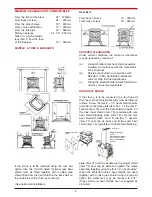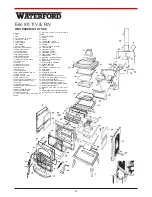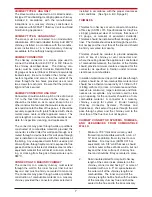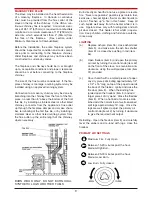
MASONRY FIRE PLACE
The stove may be installed on the hearth extension
of a masonry fireplace. In Canada a continuous
liner must be provided from the flue collar of the
stove on the top of the chimney. In the USA a con-
tinuous chimney flue is required. A minimum clear-
ance of 26 1/2” (675mm) is required to combustible
mantle and a minimum clearance of 10” (250mm) to
side trim, which extends less than 2” (50mm) from
the face of the fireplace. (See section under
Minimum Clearances to Combustibles).
Before the Installation, the entire fireplace system
should be inspected for condition and code compli-
ance prior to connecting to the fireplace chimney.
Older fireplaces and chimneys may not have been
constructed to current-day codes.
The fireplace and chimney should be in, or brought
up to, acceptable conditions and proper clearances
should be met before connecting to the fireplace
chimney.
The size of the flue must be considered. If the fire-
place chimney is too large, a relining system may be
installed using an approved relining system.
Connection to a masonry chimney may be done by
breaching into the chimney from the front of the fire-
place, no less than 8” above the bottom of the first
flue tile, by installing a stainless steel or other listed
chimney connector from the appliance’s flue outlet
up through the fireplace damper and smoke cham-
ber, terminating at the first flue tile, or by installing a
stainless steel or other listed relining system from
the flue outlet up the entire length of the chimney,
where necessary.
Burn directly on hearth do not use a grate or elevate
fire. “Never use gasoline” gasoline type lantern fuel,
kerosene, charcoal lighter fluid or smaller liquids to
start or “freshen up” a fire in this heater. Keep all
such liquids well away from the heater while it is in
use. Operate stove only with fuelling door and ash
pit door closed. This heater is hot whilst in opera-
tion. Keep children, clothing and furniture a safe dis-
tance away.
LIGHTING
(a)
Replace ashpan (item 36), close ashpit door
(item 9), and make sure the ash box shutter
(item 61) is closed by pushing in rod (item
64).
(b)
Open firedoor (item 8) and open the primary
air inlet by turning the control knob (item 42)
on the front of the stove, one revolution anti-
clockwise, using the multi-purpose tool (item
37) provided.
(c)
Cover hearth with crumpled pieces of paper.
Lay dry pieces of kindling approximately 1/2”
x 1/2” x 16” long on top of the paper towards
the back of the firebox. Ignite and close the
fire door (item 8). When the kindling has
ignited open the firedoor (item 8) and add
larger pieces of dry wood. Close the firedoor
(item 8). When a hot bed of coals is estab
lished add the normal fuel of well seasoned
split logs approximately 16” long. Once the
logs are well lighted, adjust the primary air
control knob (item 42) by turning it clockwise
to give the required heat output.
Refuelling - Open the firedoor (item 8) and carefully
level the embers and re-load with logs, close the
firedoor.
PRIMARY AIR SETTINGS
Maximum Fire. Fully Open
Between 15-20 minutes past the hour.
Medium High Burn.
Between 25-30 minutes past the hour.
Medium Low Burn.
Low Burn. Fully closed.
BURN WOOD ONLY, DO NOT BURN COAL,
SYNTHETIC LOGS OR OTHER FUELS.
9






























